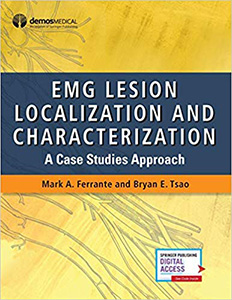Cover
Title Page
Copyright
Dedication
Contents
Case Studies
Preface
Acknowledgments
Share: EMG Lesion Localization and Characterization
Part I. The Fundamental Neuroscience Underlying Electrodiagnostic Medicine
1. Pertinent Anatomy, Physiology, and Pathology
Introductory Comments
The Goals of Electrodiagnostic Examination
The EDX Examination Is an Independent Study
Basic Anatomy and Organization of the Peripheral Neuromuscular System
Plexus Anatomy
Nerve Anatomy
Anatomy and Physiology of the Membrane
The Transmembrane Potential
Action Potential Generation
Action Potential Propagation
Connective Tissue Elements of the Nerve
Anatomy and Physiology of the Neuromuscular Junction
Presynaptic Region
Synaptic Space
Postsynaptic Region
Anatomy and Physiology of Muscle
Excitation–Contraction Coupling
Neural Control of Muscle
Motor Units, Muscle Fibers, and Force
Motor Unit Types
Muscle Fiber Types
Motor Unit Force Generation
References
2. Nerve Conduction Studies
Basic Concepts
Electrodes
Surface Recording Electrodes
Bipolar Versus Monopolar (Referential) Recording Montages
The Surface Stimulating Electrodes
The Ground Electrode
The Basic Technique
Volume Conduction
Orthodromic Versus Antidromic Techniques
Motor Nerve Conduction Studies
Belly–Tendon Method
E1 and E2 Electrode Placement
Physiologic Temporal Dispersion
What We Measure and What It Means
Amplitude
Negative Area-Under-the-Curve
Distal Latency
Conduction Velocity
Negative Phase Duration
The Value of the Motor Response
Sensory Nerve Conduction Studies
Technique
Measurements
Amplitude
The Effect of Technique (Orthodromic Versus Antidromic) on Amplitude
Latency
Peak Latencies Versus Onset Latencies
Fixed Distances Versus Landmark-Based Distances
Conduction Velocity Value Calculated From the Latency Value
Mixed Nerve Conduction Studies
The NCS Manifestations of Pathology
Introduction
How Focal Demyelination Affects Action Potential Propagation
How Focal Axon Loss Affects Action Potential Propagation
Motor NCS Manifestations
Focal Demyelinating Conduction Slowing
Uniform Demyelinating Conduction Slowing
Nonuniform Demyelinating Conduction Slowing
Focal Demyelinating Conduction Block
Lesion Localization Distal to the Two Stimulation Sites
Lesion Localization Between the Two Stimulation Sites
Lesion Localization Proximal to the Two Stimulation Sites
Conduction Failure
Advantages and Disadvantages of the Motor NCS
Sensory NCS Manifestations
Advantages and Disadvantages of the Sensory NCS
The Timing of NCS Manifestations
References
3. Repetitive Nerve Stimulation Studies
Introductory Comments
Low Frequency RNS
Postexercise Facilitation and Postexercise Exhaustion
High Frequency RNS
References
4. The Needle EMG Examination
Introductory Comments
Motor Unit Anatomy and Physiology Pertinent to Needle EMG
The Importance of the MUAP Duration
Motor Unit Recruitment
Needle EMG Technique
Needle EMG Measurements and Their Meanings
Insertional Phase
Insertional Activity
Snap-Crackle-Pop
Weichers–Johnson Syndrome
Resting Phase
Endplate Activity
Activation Phase
MUAP Amplitude
MUAP Duration
Intrinsic MUAP Morphology—Phases and Turns
MUAP Stability
References
5. Needle EMG Examination Abnormalities
Introductory Comments
Insertional Phase
Decreased Insertional Activity
“Increased” Insertional Activity
Resting Phase
Fibrillation Potentials, Positive Sharp Waves, and Insertional Positive Sharp Waves
Morphology
Auditory Characteristics and Firing Frequency
Quantification
Insertional Positive Sharp Waves
Fasciculation Potentials and Cramp Potentials
Myotonic Potentials
Neuromyotonia
Grouped Repetitive Discharges and Myokymia
Complex Repetitive Discharges
Activation Phase
MUAP Morphology
Duration
MUAP Amplitude
Phases and Turns
MUAP Recruitment
Neurogenic Recruitment
Upper Motor Neuron Recruitment
Early Recruitment
MUAP Stability
References
6. Peripheral Nerve Injuries
Introductory Comments
Nerve Injury Classification
The Seddon Classification System
The Sunderland Classification System
Nerve Injury Type
Stretch Injuries
Compression Injuries
Transection Injuries
Correlations Between Pathophysiology and Clinical Features
Correlations Between Pathophysiology and Lesion Acuteness
References
7. Assessing Lesion Severity
Introductory Comments
Clinical Grading
Electrodiagnostic Grading
The EDX Study Manifestations
EDX Manifestations Based on Severity
EDX Manifestations Based on the Timing of the Study
The Utility of the Motor Response in Lesion Severity Assessment
The Utility of the Sensory Response in Lesion Severity Assessment
The Utility of the Needle EMG in Lesion Severity Assessment
Fibrillation Potentials
Motor Unit Action Potentials
Recruitment
Duration
Mechanisms of Reinnervation
Collateral Sprouting
Proximodistal Axon Regeneration
Determining the Potential for Reinnervation
References
8. Lesion Localization and Characterization
Lesion Localization
Nerve Conduction Studies
The Cell Bodies of Origin of the Sensory and Motor Axons
Nerve Conduction Studies and Needle EMG Study
An Example of Lesion Localization
Lesion Characterization
Example 1—Calculating Axon Loss and Demyelinating Conduction Block Severity Using the Motor Responses
Determinations Required
Solution
The Percentage of Fibers Affected by Axon Loss
The Percentage of Fibers Affected by Demyelinating Conduction Block
The Percentage of Fibers Unaffected
Example 2—Sample EDX Case and Terminology
Clinical Impression
Initial Set of Sensory NCS
Sensory Nerve Conduction Studies
Motor Nerve Conduction Studies
The Needle EMG Study
EDX Study Conclusion
Left Ulnar Neuropathy at the Elbow Segment
The Calculations Determining These Pathophysiologies
Motor Nerve Fibers to the ADM Muscle
Motor Nerve Fibers to the FDI Muscle
Final Comments
Example 3—Using Deductive Reasoning to Identify a Proximal Demyelinating Conduction Block
MUAP Waveform Analysis
MUAP Measurements and Stability
MUAP Recruitment Pattern Analysis
Reference
Part II. Case Studies in Electrodiagnostic Medicine
9. Case Studies
Introductory Comments
EDX Case Study Organization
The Case-Box
Table Descriptors
MUAP Recruitment Descriptors
MUAP Morphology Descriptors
When the Needle EMG Findings Vary
Abbreviations Used
Sensory NCS
Motor NCS
Needle EMG
Upper Extremity
Lower Extremity
EDX Case Studies
Introduction
Regional Disorders of the Upper and Lower Extremities (Cases 1 Through 19)
Multiregional Disorders of the Upper and Lower Extremities (Cases 20 Through 30)
Brachial Plexopathies (Cases 31 Through 39)
Generalized Disorders (Cases 40 Through 56)
Challenging EDX Cases (Cases 57 Through 60)
Index


